Abstract
The susceptibility of 173 TEM-1-producing isolates of Escherichia coli was assessed by determination of MICs by the agar dilution method. MICs of amoxicillin, mezlocillin, cephaloridine, and, to a smaller extent, amoxicillin-clavulanic acid (but not cephalexin, cefuroxime, cefotaxime, ceftazidime, or imipenem) were higher for isolates that produced large amounts of beta-lactamase than for isolates that produced smaller amounts. The effect of fixed concentrations of clavulanic acid on resistance to amoxicillin was assessed for 34 selected TEM-1-producing isolates. Low concentrations of the inhibitor (0.5 to 1 microgram/ml) reduced the amoxicillin MICs substantially for almost all the isolates, although the reductions were not sufficient to render any of the isolates amoxicillin susceptible. Higher concentrations of clavulanic acid had progressively greater effects on amoxicillin MICs, but even at 8 micrograms/ml some of the isolates with high beta-lactamase activities remained resistant or only moderately susceptible to amoxicillin. All the isolates were inhibited by clavulanic acid (in the absence of amoxicillin) at concentrations of 16 to 32 micrograms/ml. TEM-1 beta-lactamase activity was inhibited in vitro by clavulanic acid, but not totally, with approximately 2% of the initial activity remaining at 2 micrograms/ml and 0.4% remaining at 8 micrograms/ml. These findings suggest that the amount of beta-lactamase activity is a major determinant of the degree of resistance to several beta-lactam antibiotics and can make the difference between susceptibility and resistance to some compounds, notably the combination of amoxicillin with clavulanic acid.
Full text
PDF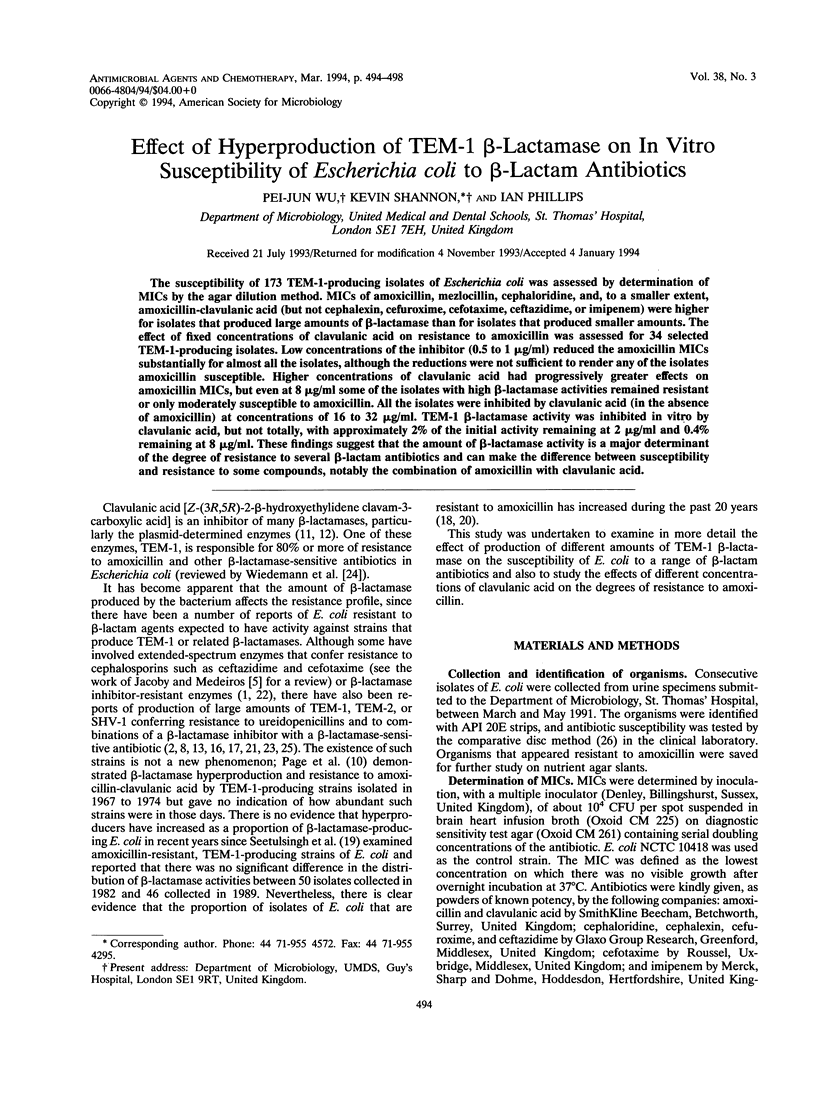
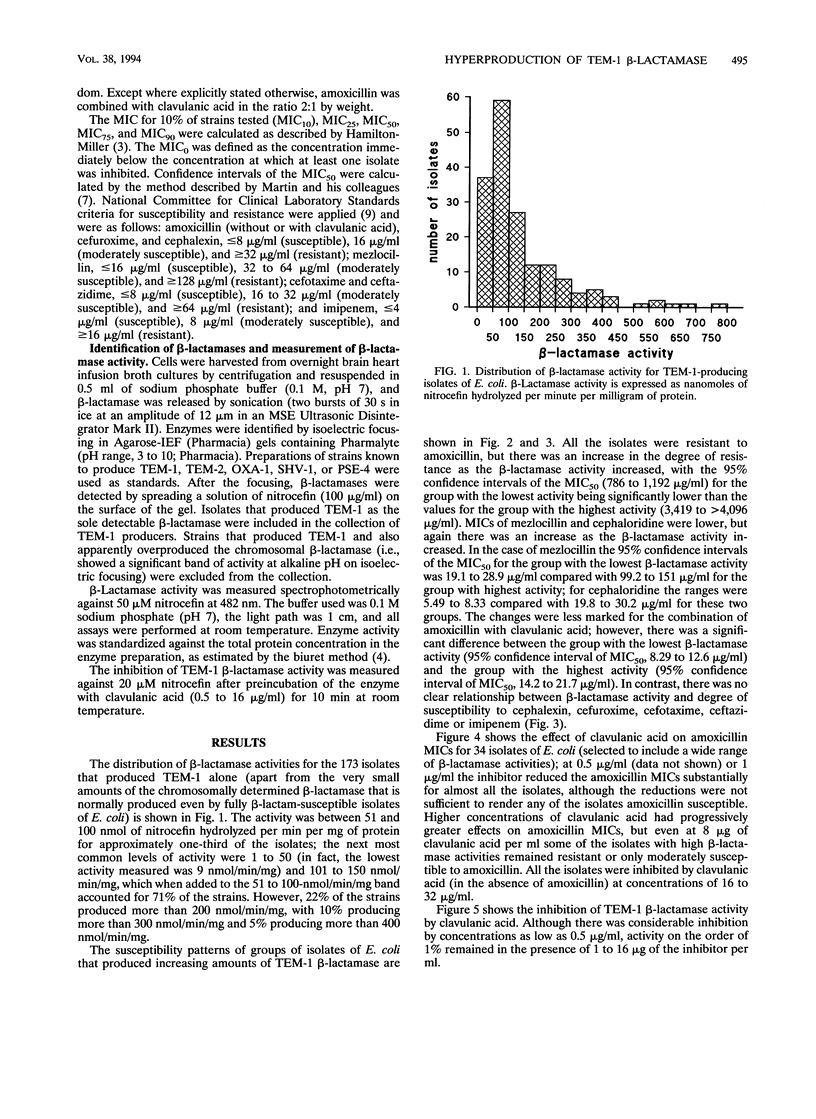
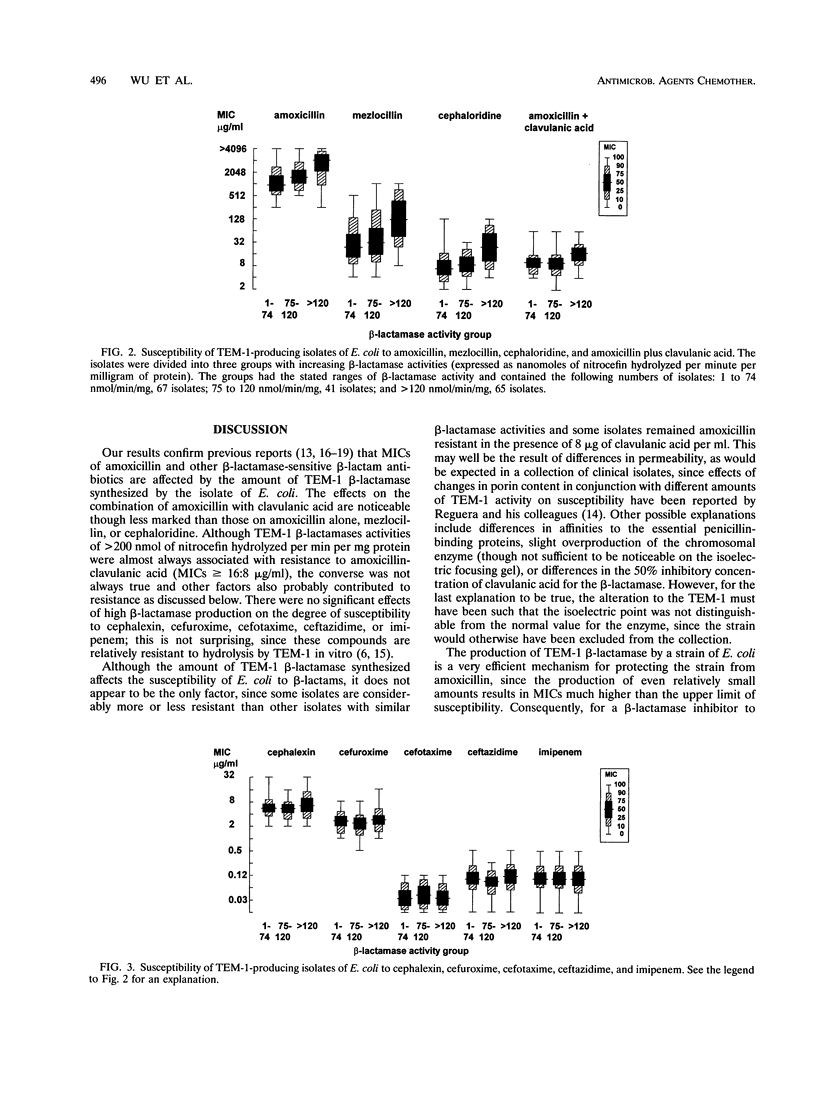
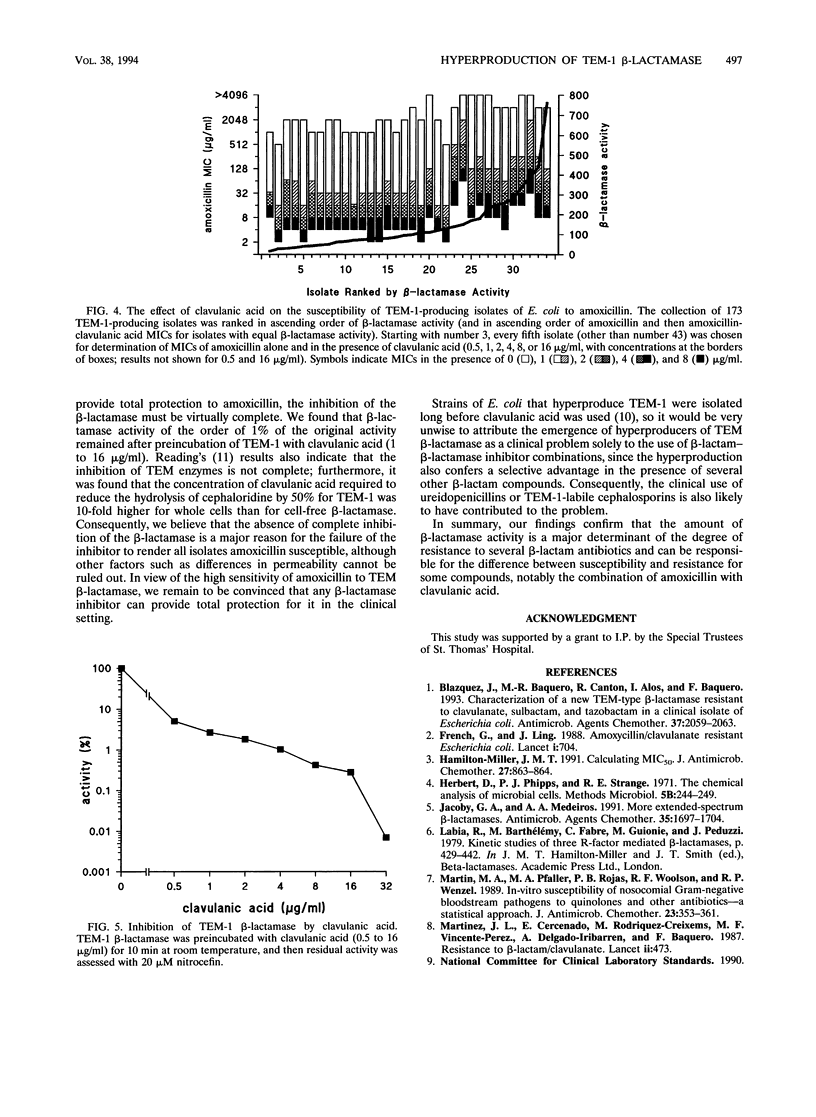
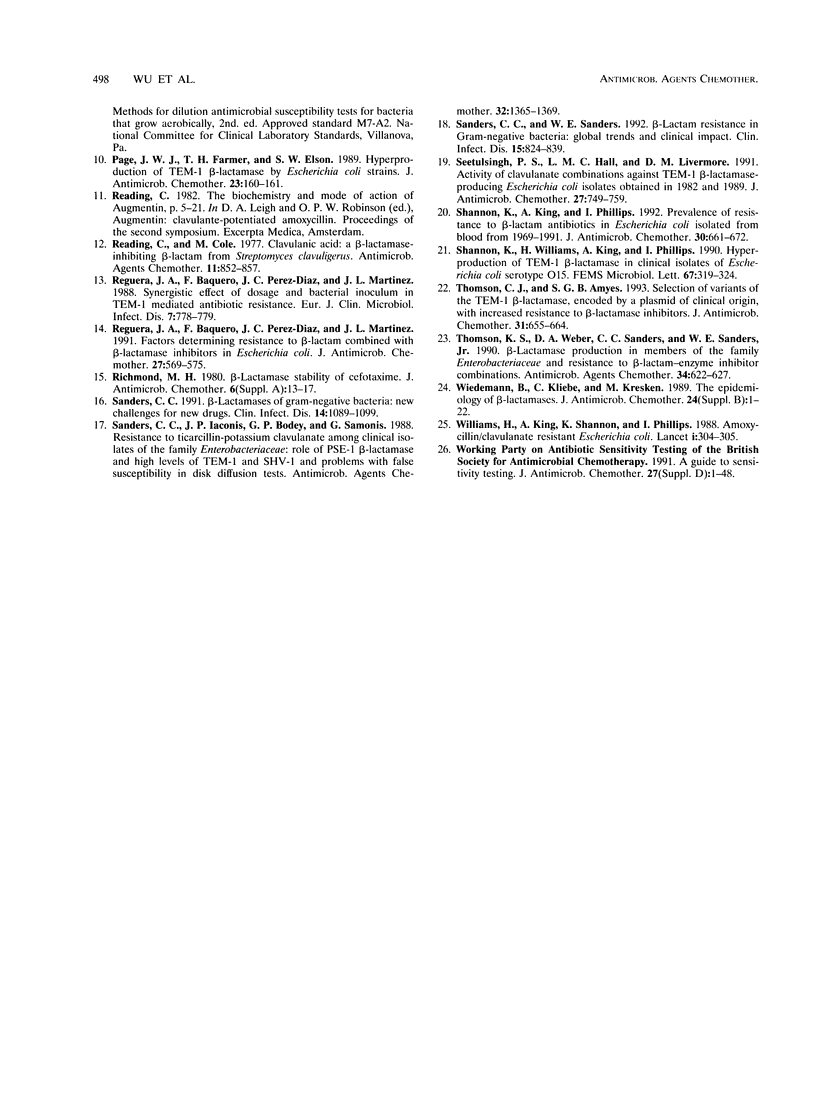
Selected References
These references are in PubMed. This may not be the complete list of references from this article.
- Blazquez J., Baquero M. R., Canton R., Alos I., Baquero F. Characterization of a new TEM-type beta-lactamase resistant to clavulanate, sulbactam, and tazobactam in a clinical isolate of Escherichia coli. Antimicrob Agents Chemother. 1993 Oct;37(10):2059–2063. doi: 10.1128/aac.37.10.2059. [DOI] [PMC free article] [PubMed] [Google Scholar]
- French G., Ling T. Amoxycillin/clavulanate resistant Escherichia coli. Lancet. 1988 Mar 26;1(8587):704–704. doi: 10.1016/s0140-6736(88)91500-0. [DOI] [PubMed] [Google Scholar]
- Hamilton-Miller J. M. Calculating MIC50. J Antimicrob Chemother. 1991 Jun;27(6):863–864. doi: 10.1093/jac/27.6.863. [DOI] [PubMed] [Google Scholar]
- Jacoby G. A., Medeiros A. A. More extended-spectrum beta-lactamases. Antimicrob Agents Chemother. 1991 Sep;35(9):1697–1704. doi: 10.1128/aac.35.9.1697. [DOI] [PMC free article] [PubMed] [Google Scholar]
- Martin M. A., Pfaller M. A., Rojas P. B., Woolson R. F., Wenzel R. P. In-vitro susceptibility of nosocomial gram-negative bloodstream pathogens to quinolones and other antibiotics--a statistical approach. J Antimicrob Chemother. 1989 Mar;23(3):353–361. doi: 10.1093/jac/23.3.353. [DOI] [PubMed] [Google Scholar]
- Page J. W., Farmer T. H., Elson S. W. Hyperproduction of TEM-1 beta-lactamase by Escherichia coli strains. J Antimicrob Chemother. 1989 Jan;23(1):160–161. doi: 10.1093/jac/23.1.160. [DOI] [PubMed] [Google Scholar]
- Reading C., Cole M. Clavulanic acid: a beta-lactamase-inhiting beta-lactam from Streptomyces clavuligerus. Antimicrob Agents Chemother. 1977 May;11(5):852–857. doi: 10.1128/aac.11.5.852. [DOI] [PMC free article] [PubMed] [Google Scholar]
- Reguera J. A., Baquero F., Perez-Diaz J. C., Martinez J. L. Synergistic effect of dosage and bacterial inoculum in TEM-1 mediated antibiotic resistance. Eur J Clin Microbiol Infect Dis. 1988 Dec;7(6):778–779. doi: 10.1007/BF01975047. [DOI] [PubMed] [Google Scholar]
- Reguera J. A., Baquero F., Pérez-Díaz J. C., Martínez J. L. Factors determining resistance to beta-lactam combined with beta-lactamase inhibitors in Escherichia coli. J Antimicrob Chemother. 1991 May;27(5):569–575. doi: 10.1093/jac/27.5.569. [DOI] [PubMed] [Google Scholar]
- Richmond M. H. beta-Lactamase stability of cefotaxime. J Antimicrob Chemother. 1980 Sep;6 (Suppl A):13–17. doi: 10.1093/jac/6.suppl_a.13. [DOI] [PubMed] [Google Scholar]
- Sanders C. C., Iaconis J. P., Bodey G. P., Samonis G. Resistance to ticarcillin-potassium clavulanate among clinical isolates of the family Enterobacteriaceae: role of PSE-1 beta-lactamase and high levels of TEM-1 and SHV-1 and problems with false susceptibility in disk diffusion tests. Antimicrob Agents Chemother. 1988 Sep;32(9):1365–1369. doi: 10.1128/aac.32.9.1365. [DOI] [PMC free article] [PubMed] [Google Scholar]
- Sanders C. C., Sanders W. E., Jr beta-Lactam resistance in gram-negative bacteria: global trends and clinical impact. Clin Infect Dis. 1992 Nov;15(5):824–839. doi: 10.1093/clind/15.5.824. [DOI] [PubMed] [Google Scholar]
- Sanders C. C. beta-Lactamases of gram-negative bacteria: new challenges for new drugs. Clin Infect Dis. 1992 May;14(5):1089–1099. doi: 10.1093/clinids/14.5.1089. [DOI] [PubMed] [Google Scholar]
- Seetulsingh P. S., Hall L. M., Livermore D. M. Activity of clavulanate combinations against TEM-1 beta-lactamase-producing Escherichia coli isolates obtained in 1982 and 1989. J Antimicrob Chemother. 1991 Jun;27(6):749–759. doi: 10.1093/jac/27.6.749. [DOI] [PubMed] [Google Scholar]
- Shannon K., King A., Phillips I. Prevalence of resistance to beta-lactam antibiotics in Escherichia coli isolated from blood from 1969-1991. J Antimicrob Chemother. 1992 Nov;30(5):661–672. doi: 10.1093/jac/30.5.661. [DOI] [PubMed] [Google Scholar]
- Shannon K., Williams H., King A., Phillips I. Hyperproduction of TEM-1 beta-lactamase in clinical isolates of Escherichia coli serotype O15. FEMS Microbiol Lett. 1990 Feb;55(3):319–323. doi: 10.1016/0378-1097(90)90016-j. [DOI] [PubMed] [Google Scholar]
- Thomson C. J., Amyes S. G. Selection of variants of the TEM-1 beta-lactamase, encoded by a plasmid of clinical origin, with increased resistance to beta-lactamase inhibitors. J Antimicrob Chemother. 1993 May;31(5):655–664. doi: 10.1093/jac/31.5.655. [DOI] [PubMed] [Google Scholar]
- Thomson K. S., Weber D. A., Sanders C. C., Sanders W. E., Jr Beta-lactamase production in members of the family Enterobacteriaceae and resistance to beta-lactam-enzyme inhibitor combinations. Antimicrob Agents Chemother. 1990 Apr;34(4):622–627. doi: 10.1128/aac.34.4.622. [DOI] [PMC free article] [PubMed] [Google Scholar]
- Wiedemann B., Kliebe C., Kresken M. The epidemiology of beta-lactamases. J Antimicrob Chemother. 1989 Nov;24 (Suppl B):1–22. doi: 10.1093/jac/24.suppl_b.1. [DOI] [PubMed] [Google Scholar]
- Williams H., King A., Shannon K., Phillips I. Amoxycillin/clavulanate resistant Escherichia coli. Lancet. 1988 Feb 6;1(8580):304–305. doi: 10.1016/s0140-6736(88)90391-1. [DOI] [PubMed] [Google Scholar]


